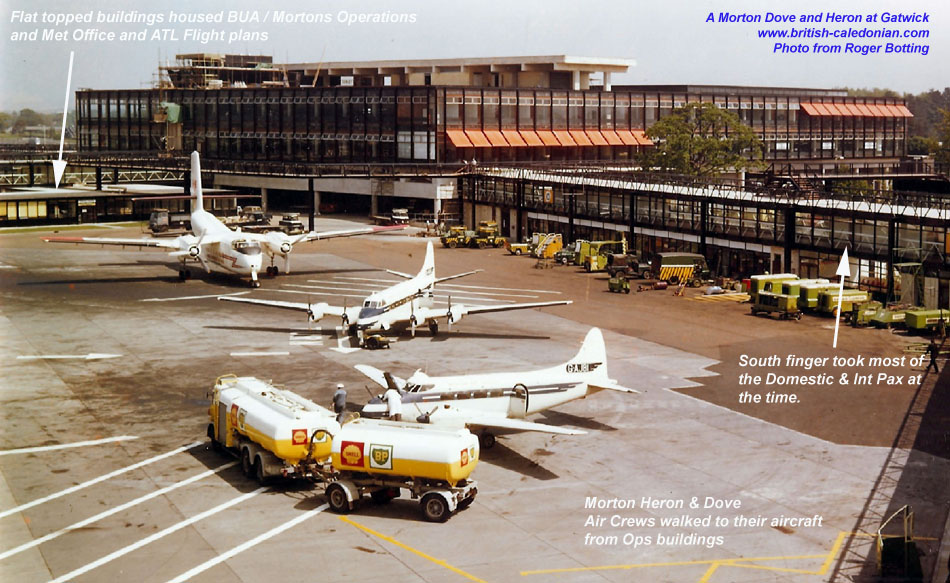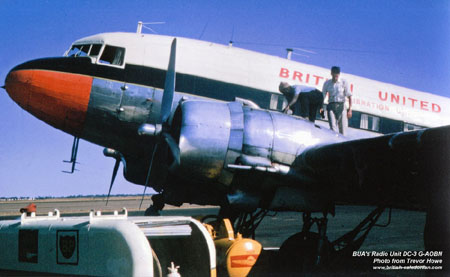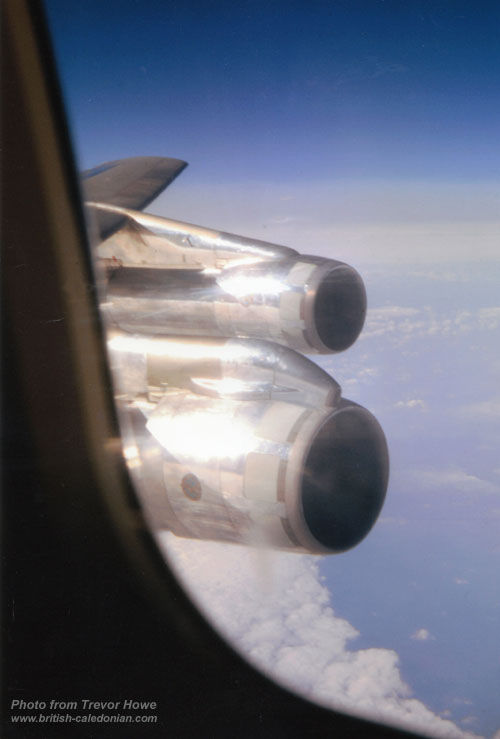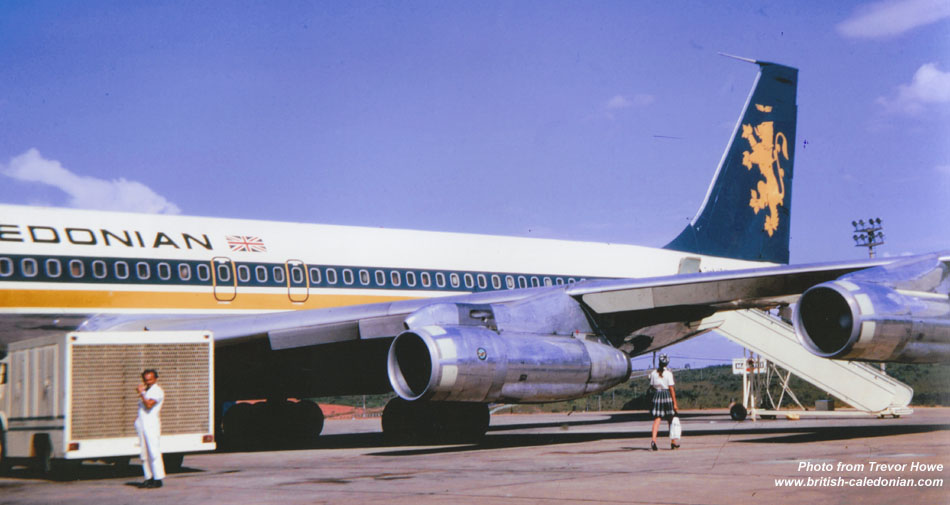The Trevor Howe Gallery
Here Trevor recounts some of his flying career from 1965 with Mortons to Fly Go in 2005
Here Trevor recounts some of his flying career from 1965 with Mortons to Fly Go in 2005

In an attempt to escape the concrete of Heathrow, a young man drove over Reigate Hill on a sunny May morning in 1965 and looked down on to the beautiful sight of Gatwick Airport. He was going for an interview with the Chief Pilot of Morton Airways, captain Tommy Gunn DFC, who made a cup of coffee and offered a s/o salary of £750, rising to f/o £1,000 after six months. A HERON command could be had when an ALTP was achieved; the time to command in BEA and BOAC at the time was over 20 years.
In Mortonís the flying averaged 1000 hours each year and most pilots flew the DC3ís, Herons and Doves, with the DC3s Having the wonderful Transair modifications. Having done an ATC flying scholarship on Austers and a full CPL on Chipmunks, propeller aircraft were considered extremely attractive and interesting to a fledgling airline pilot.
In Mortonís the flying averaged 1000 hours each year and most pilots flew the DC3ís, Herons and Doves, with the DC3s Having the wonderful Transair modifications. Having done an ATC flying scholarship on Austers and a full CPL on Chipmunks, propeller aircraft were considered extremely attractive and interesting to a fledgling airline pilot.


There were an amazing host of characters in Mortons; which was part of the BUA group. Geoff Last was the last pilot to fly out of Croydon; Joe Rechka started on DC2ís and Norman Leedham was an ex Aquilla flying boat captain. Yvonne Pope was the first woman airline pilot, Charles Argles had 20,000 flying hours by the time he was forty and Dan Skillman DFC who left British South American Airways a week before it was taken over by BOAC.
The Heron was a beautiful aircraft to fly, with many flights to the Channel Islands. Alderney, Southampton, Oxford and Plymouth were grass airfields. Some interesting flights included over-flying the Torrey Canyon shipwreck off Cornwall, looking for the first gas fire in the North Sea, taking Atomic Energy boffins Manchester, Abingdon, Bournemouth, and Fords at Southend, Antwerp and Albert Speer Berlin to Cologne.
The Heron was a beautiful aircraft to fly, with many flights to the Channel Islands. Alderney, Southampton, Oxford and Plymouth were grass airfields. Some interesting flights included over-flying the Torrey Canyon shipwreck off Cornwall, looking for the first gas fire in the North Sea, taking Atomic Energy boffins Manchester, Abingdon, Bournemouth, and Fords at Southend, Antwerp and Albert Speer Berlin to Cologne.


Mortonís operated the British United Radio calibration DC3, G-AOBN, and a fascinating trip was had in early 1966 as first officer.
Cairo to Khartoum in 6 Ĺ hours with no sign of Generals Kitchiner or Gordon, VOR calibration at an isolated strip of concrete in the dessert called Doha. Iraq Airways flying Tridents out of a pleasant and peaceful Bagdad.
In 1968, crews converted onto the Dart Heralds of BUIA with night stops in Blackpool, Southampton, Jersey and Exeter, which was the favourite, with an old Ford Anglia car and a T-bone steak dinner could be had for 25 shillings and 6 pence at Ye Olde Shippe Inn.
Cairo to Khartoum in 6 Ĺ hours with no sign of Generals Kitchiner or Gordon, VOR calibration at an isolated strip of concrete in the dessert called Doha. Iraq Airways flying Tridents out of a pleasant and peaceful Bagdad.
In 1968, crews converted onto the Dart Heralds of BUIA with night stops in Blackpool, Southampton, Jersey and Exeter, which was the favourite, with an old Ford Anglia car and a T-bone steak dinner could be had for 25 shillings and 6 pence at Ye Olde Shippe Inn.


British United itself had a fine street of 1-11ís and VC10ís, they had virtually designed the 1-11, with its ĎTí flying panel which is standard everywhere today. The VC10 flew schedules to South America and Africa.
The takeover of BUA by Caledonian in 1970 led to the unexpected chance to fly on jet aircraft, having reluctantly been put onto the 707 rather than the VC10, the training was at a white elephant airfield in the Florida everglades called Dade Collier. The landing fee was £2 for each landing and the training aircraft flew almost 20 hours per day after the alligators had been cleared from the runway each morning.
The 707 was not the easiest aircraft to fly, with a tendency to move around in all directions and all approaches had to be flown by hand. However, the reliability was quite amazing, with virtually no engine failures in Ten years, and personally only two technical delays in that time.
The crews could not believe that Navigators could be replaced, but in 1975 INS navigation took over.
Operating the 707 was a great experience, with crew members from the old airlines of Transair, Hunting, Airwork, Air Charter, Silver City, BUAF as well as the original CALEDONIAN.
The crew of 10 was easy to manage, and the schedules to Africa and South America were mixed with charters to North America and South America and the Far East.
Stopovers in Nairobi were a dream, with crews staying at The Old Colonial Hotel, the NORFOLK, by virtue of an old SAFARI contract. At 5500 feet the aircraft had to be fitted with 220 mph tyres due to the very high take off speeds which included quite a few heavy cargo flights.
The takeover of BUA by Caledonian in 1970 led to the unexpected chance to fly on jet aircraft, having reluctantly been put onto the 707 rather than the VC10, the training was at a white elephant airfield in the Florida everglades called Dade Collier. The landing fee was £2 for each landing and the training aircraft flew almost 20 hours per day after the alligators had been cleared from the runway each morning.
The 707 was not the easiest aircraft to fly, with a tendency to move around in all directions and all approaches had to be flown by hand. However, the reliability was quite amazing, with virtually no engine failures in Ten years, and personally only two technical delays in that time.
The crews could not believe that Navigators could be replaced, but in 1975 INS navigation took over.
Operating the 707 was a great experience, with crew members from the old airlines of Transair, Hunting, Airwork, Air Charter, Silver City, BUAF as well as the original CALEDONIAN.
The crew of 10 was easy to manage, and the schedules to Africa and South America were mixed with charters to North America and South America and the Far East.
Stopovers in Nairobi were a dream, with crews staying at The Old Colonial Hotel, the NORFOLK, by virtue of an old SAFARI contract. At 5500 feet the aircraft had to be fitted with 220 mph tyres due to the very high take off speeds which included quite a few heavy cargo flights.

Above Captain Roy Wilson in Nairobi, below the old Airport and also the Norfolk Hotel
Another tight take off was at Los Angeles, where BCAL were the only airline to fly direct to London and the locals come out to watch BCAL scrape off the longest runway and begin a very slow climb out over the Pacific before the Sierra Nevada. Rio de Janeiro was spectacular if overpowering, with crews having a lot of cheap eating places along Copacabana Beach where they could discuss whether anyone had seen Ronnie Biggs that day. A well-publicised event resulted in an empty seat on a BCAL flight when Superintendent Slipper failed to get him extradited from Brazil. Below a 707 down route in South America in 1976.


Hong Kong was still colonial up to the 1980ís handover, and Singapore very modern with Raffles Hotel still there, despite of the fact that no crew member could ever afford to drink there.
Chile was one of the nicest countries on the route network, with access to the Prince of Wales country club. There was a short period of luxury when the currency collapsed to 30,000 to the dollar and the crews could dine on the top floor at the Carrera Hotel which would have been otherwise unheard of. There were a large amount of Cargo flights around the world, including animals flown very long distances.
BCAL held a large number of performance records for the 707 aircraft, non-stop Singapore to London, Rio to London and Los Angeles to London. In the fuel crisis of the mid 1970ís BCAL pioneered fuel saving techniques which were copied by all other airlines around the world.
1980 and on to short haul with the 1-11, BUA pioneered jet short haul routes in UK and Europe in the 1960ís and 1970ís and continued to expand into Europe, North Africa and West Africa with BCAL.
Throughout all this time the wonderful standards of all the BCAL departments were ever present. The cabin service was legendary and engineering was of the highest order. Passenger handing was of a very high standard along with ground handling operations on the ramp. The top management team had a vast knowledge of the airline business, in particular of course Sir Adam Thompson himself.
On top of all this was the feeling of being in a family firm in spite of its size. This also applied to Gatwick Airport itself which could be compared to a large flying club.
Chile was one of the nicest countries on the route network, with access to the Prince of Wales country club. There was a short period of luxury when the currency collapsed to 30,000 to the dollar and the crews could dine on the top floor at the Carrera Hotel which would have been otherwise unheard of. There were a large amount of Cargo flights around the world, including animals flown very long distances.
BCAL held a large number of performance records for the 707 aircraft, non-stop Singapore to London, Rio to London and Los Angeles to London. In the fuel crisis of the mid 1970ís BCAL pioneered fuel saving techniques which were copied by all other airlines around the world.
1980 and on to short haul with the 1-11, BUA pioneered jet short haul routes in UK and Europe in the 1960ís and 1970ís and continued to expand into Europe, North Africa and West Africa with BCAL.
Throughout all this time the wonderful standards of all the BCAL departments were ever present. The cabin service was legendary and engineering was of the highest order. Passenger handing was of a very high standard along with ground handling operations on the ramp. The top management team had a vast knowledge of the airline business, in particular of course Sir Adam Thompson himself.
On top of all this was the feeling of being in a family firm in spite of its size. This also applied to Gatwick Airport itself which could be compared to a large flying club.
Another accidental bonus around Gatwick was the wonderful grass airfield at Redhill, an Auster aircraft was kept there and quite a number of BCAL people had a chance to fly in an historic aircraft and get a wonderful view of the Surrey countryside.

But back to Boeings again, and after the 1988 BA takeover I managed to hang on at Gatwick until 1995. Finally had to go to Heathrow after 30 wonderful years at Gatwick, but in fact Heathrow wasnít too bad with the new privatised BA.
Retirement in 1998 and off to GO FLY at Stansted which was very like Gatwick in the 1960ís, a huge modern airport in the middle of a beautiful countryside. A wonderful boss, Barbara Cassani, was the equivalent of Sir Adam Thompson, and kept a happy airline together until EASYJET overpaid for it. However Barbara had made sure that all the staff had got shares in exactly the same way that Adam had done in the 1980ís. Very pleasant spells at Bristol, East Midlands and Newcastle completed 40 years in the business.
The BCAL website is an absolutely wonderful collection of memories from all the ex BCAL employees which will never be equalled. Well done everybody.
Retirement in 1998 and off to GO FLY at Stansted which was very like Gatwick in the 1960ís, a huge modern airport in the middle of a beautiful countryside. A wonderful boss, Barbara Cassani, was the equivalent of Sir Adam Thompson, and kept a happy airline together until EASYJET overpaid for it. However Barbara had made sure that all the staff had got shares in exactly the same way that Adam had done in the 1980ís. Very pleasant spells at Bristol, East Midlands and Newcastle completed 40 years in the business.
The BCAL website is an absolutely wonderful collection of memories from all the ex BCAL employees which will never be equalled. Well done everybody.
